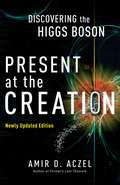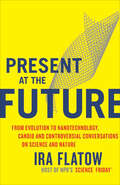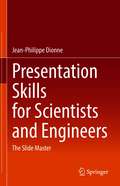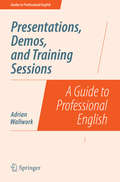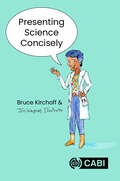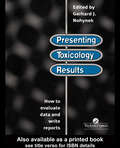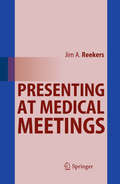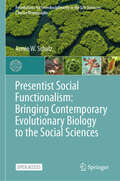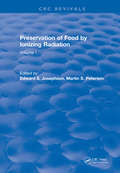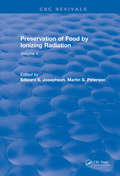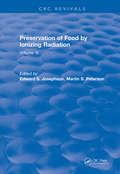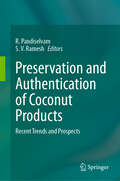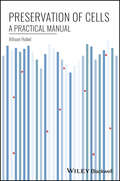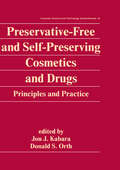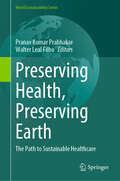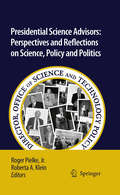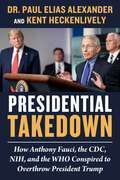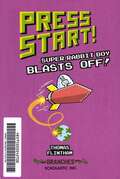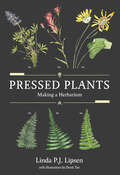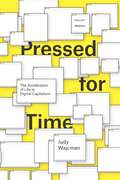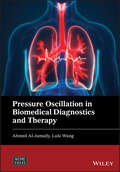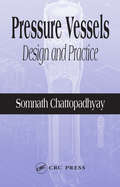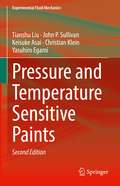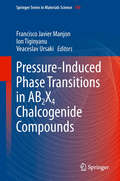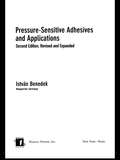- Table View
- List View
Present at the Creation: Discovering the Higgs Boson
by Amir D. AczelThe Large Hadron Collider is the biggest, and by far the most powerful, machine ever built. A project of CERN, the European Organization for Nuclear Research, its audacious purpose is to re-create, in a 16.5-mile-long circular tunnel under the French-Swiss countryside, the immensely hot and dense conditions that existed some 13.7 billion years ago within the first trillionth of a second after the fiery birth of our universe. The collider is now crashing protons at record energy levels never created by scientists before, and it will reach even higher levels by 2013. Its superconducting magnets guide two beams of protons in opposite directions around the track. After accelerating the beams to 99.9999991 percent of the speed of light, it collides the protons head-on, annihilating them in a flash of energy sufficient--in accordance with Einstein's elegant statement of mass-energy equivalence, E=mc2--to coalesce into a shower of particles and phenomena that have not existed since the first moments of creation. Within the LHC's detectors, scientists hope to see empirical confirmation of key theories in physics and cosmology.In telling the story of what is perhaps the most anticipated experiment in the history of science, Amir D. Aczel takes us inside the control rooms at CERN at key moments when an international team of top researchers begins to discover whether this multibillion-euro investment will fulfill its spectacular promise. Through the eyes and words of the men and women who conceived and built CERN and the LHC--and with the same clarity and depth of knowledge he demonstrated in the bestselling Fermat's Last Theorem--Aczel enriches all of us with a firm grounding in the scientific concepts we will need to appreciate the discoveries that will almost certainly spring forth when the full power of this great machine is finally unleashed.Will the Higgs boson make its breathlessly awaited appearance, confirming at last the Standard Model of particles and their interactions that is among the great theoretical achievements of twentieth-century physics? Will the hidden dimensions posited by string theory be revealed? Will we at last identify the nature of the dark matter that makes up more than 90 percent of the cosmos? With Present at the Creation, written by one of today's finest popular interpreters of basic science, we can all follow the progress of an experiment that promises to greatly satisfy the curiosity of anyone who ever concurred with Einstein when he said, "I want to know God's thoughts--the rest is details."From the Hardcover edition.
Present at the Future: From Evolution to Nanotechnology, Candid and Controversial Conversations on Science and Nature
by Ira FlatowVeteran NPR® science correspondent and award-winning radio and TV journalist Ira Flatow's enthusiasm for all things science has made him a beloved on-air journalist. For more than thirty-five years, Flatow has interviewed the top scientists and researchers on many NPR and PBS programs, including his popular Science Friday® spot on Talk of the Nation. In Present at the Future, he shares the groundbreaking revelations from those conversations, including the latest on nanotechnology, space travel, global warming, alternative energies, stem cell research, and using the universe as a super–super computer. Flatow also further explores his favorite topic of the science of everyday life with explanations on why the shower curtain sticks to you, the real story of why airplanes fly, and much more.From dark matter and the human consciousness to the surprising number of scientists who believe in a Creator, Present at the Future reveals the mysteries of science, nature, and technology that shape our lives.
Presentation Skills for Scientists and Engineers: The Slide Master
by Jean-Philippe DionneThis book provides concise and effective tips spanning all relevant areas to deliver engaging scientific presentations. Readers will strengthen their skills in preparing, practicing and delivering presentations at both physical and virtual conferences and seminars. Best practices for structuring presentations and elements to include and those to exclude such as detailed sections on the use of videos, animations and tables are included. Common errors often seen in scientific presentations are highlighted along with tips on how to interact with audiences and keep them engaged. This will be a valuable resource for scientists in all areas of chemistry and materials science as well as engineers who wish to elevate their scientific presentations.
Presentations, Demos, and Training Sessions: A Guide to Professional English (Guides to Professional English)
by Adrian WallworkThis is the first book ever for non-native speakers on how to conduct technical demos and training sessions. You will also learn how to present your company, and explain your products and services. The book is designed to help both those who have never done presentations before, as well as those whose English is already good but who want to improve their presentation skills.The focus is on language, rather than on the creation of slides from a technical/artistic point of view. This book will help you to:prepare and practice a well organized, interesting and memorable presentationgive effective demos and training sessions either on site or via audio/video conferencehighlight the essential points you want the audience to rememberavoid problems in English by using short easy-to-say sentencesinvolve your audience, check their understanding, and deal with their questionsimprove your pronunciationovercome problems with nerves and embarrassmentmotivate your audience to listen and act on what you have saidThere is an introduction for trainers on how to teach presentations and demos within a Business English course.
Presenting Science Concisely
by Dr Bruce KirchoffImagine you are a scientist faced with presenting your research clearly and concisely. Where would you go for help? This book provides the answer. It shows how to use story structure to craft clear, credible presentations. In it you will find exercises to help you give both short and long presentations. Elevator pitches, lightning talks, Three Minute Thesis (3MT®), and conference presentations are all covered as are suggestions for longer presentations. Separate chapters address good poster design, how to tailor your talk to an audience, and presentation skills. Throughout the book the focus is on creating surprising, memorable stories. Scientific presentations are true stories about new discoveries. They are surprising because every new discovery changes our understanding of the world, and memorable because they move audiences. The book also covers: · Randy Olson's And-But-Therefore (ABT) narrative form · Mike Morrison's Better Poster designs · Eye-tracking analyses of posters by EyeQuant · Numerous case studies and examples from different scientific fields · Links to videos of exemplary presentations With light-hearted illustrations by Jon Wagner this book will appeal to researchers and graduate students in all areas of science, and other disciplines too.
Presenting Toxicology Results: How to Evaluate Data and Write Reports
by G. J. NohynekWritten in such a way as to make it accessible to toxicologists who do not have English as a first language, this book focuses on evaluating, interpreting and reporting results of regulatory toxicology studies.
Presenting at Medical Meetings
by Jim A. ReekersLectures on scientific data, educational lectures, and the various other forms of oral presentation are the basis for every medical meeting. Physicians are not professionally trained in giving lectures. This becomes very obvious when one visits a medical meeting. Often the message of the presentation is lost because of poor preparation, slides that fail to communicate effectively, and a generally unconvincing performance by the lecturer. To give a high-quality lecture that will be remembered for its content and form, one first has to learn some basic rules about preparation, PowerPoint slides, and oral communication. This book will enable the reader to overcome all the common presentation mistakes and to start a new career as a professional lecturer and esteemed faculty member.
Presentist Social Functionalism: Bringing Contemporary Evolutionary Biology to the Social Sciences (Foundations for Interdisciplinarity in the Life Sciences: Concise Monographs)
by Armin W. SchulzThis open access book presents and defends a new approach towards social functionalism: Presentist Social Functionalism. This approach draws on recent developments in evolutionary biology and philosophy of biology to provide a more compelling theoretical foundation for functionalist social analysis. Functionalist approaches to the social sciences—which aim at using facts about what social institutions are for to provide a fulcrum with which to understand, evaluate, and respond to social reality—are about as old as the subject itself, but have also been the subject of much criticism. In particular, a widespread concern for the functionalist tradition in the social sciences is that functional ascriptions often lack a plausible theoretical grounding, and that where such a theoretical grounding can be provided, the empirical presuppositions of this grounding often fail to be met. However, recent developments in evolutionary biology and the philosophy of biology promise to change this situation: they show that functional ascription can be compellingly made in an ahistorical, non-reproduction-based, and non-normative manner, which makes it possible to develop a new account of social functionalism that can fulfil the latter&’s theoretical and empirical desiderata. To show this, the book begins by laying out the major existing accounts of social functionalism and detailing their challenges. It then develops the new, alternative account of Presentist Social Functionalism. Given its interdisciplinary nature and application-focused approach, the book is of interest to researchers in a variety of fields, from evolutionary biology to the social sciences and philosophy.
Preservation Of Food By Ionizing Radiation: Volume I
by JosephsonFood Scientists the world over should keep abreast of advances in konwledge and techniques in this developing new food process. The place to start is with these three volumes, which are, without question, the most comprehensive and the most authoritative source fo information on the basic science and technology yet published on food preservation by the application of ionizing radiation.
Preservation Of Food By Ionizing Radiation: Volume II
by Van C JosephsonFood Scientists the world over should keep abreast of advances in konwledge and techniques in this developing new food process. The place to start is with these three volumes, which are, without question, the most comprehensive and the most authoritative source fo information on the basic science and technology yet published on food preservation by the application of ionizing radiation.
Preservation Of Food By Ionizing Radiation: Volume III
by Peter JosephsonFood Scientists the world over should keep abreast of advances in konwledge and techniques in this developing new food process. The place to start is with these three volumes, which are, without question, the most comprehensive and the most authoritative source fo information on the basic science and technology yet published on food preservation by the application of ionizing radiation.
Preservation and Authentication of Coconut Products: Recent Trends and Prospects
by S. V. Ramesh R. PandiselvamCoconut is an important economic crop widely cultivated in island and coastal ecosystems in the tropical and sub-tropical regions of the world. Emerging trends in biochemical characterization have highlighted the nutraceutical and nutritional importance of coconut and its products. However, the short shelf life of these products seriously restricts their market potential. Coconut beverages such as coconut water, inflorescence sap and coconut milk have numerous health promoting nutrients, although the highly perishable nature of coconut beverages and products causes significant post-harvest losses. Conventional thermal technologies implemented by the coconut processing industry affect the heat sensitive nutrients and create a negative impact on the color and flavor profiles of the products. Producers have been looking for an efficient alternative to thermal technologies, although most of the emerging non-thermal technologies such as cold plasma, ozone, pulsed light, UV-light, pulsed electric field and high-pressure processing are in lab scale. It is important to understand the practical application of these technologies at industry scale. Also, it is important to analyze the influence and application of these emerging technologies on the quality profile, safety and shelf-life extension of the products. The adulteration rate in coconut products has been increasing along with their prices, making it vital to understand the application of non-destructive tools for authentication. Preservation and Authentication of Coconut Products: Recent Trends and Prospects offers comprehensive coverage on the application of emerging technologies in coconut and coconut-based products. Present industrial technologies for coconut products and their impact on quality are covered in full, including technologies for each specific product and their challenges and prospects. Non-destructive tools and applications for the quantification of bioactive components and authentication are also explored. This book serves as a one-stop reference for researchers, food technologists, food industry specialists and nutritionists looking to understand the implications of emerging food processing technologies on the quality of coconut products.
Preservation of Cells: A Practical Manual
by Allison HubelHelps those that use cell preservation to develop new protocols or improve existing protocols This book provides readers with the tools needed to develop or debug a preservation protocol for cells. The core structure and content of the text grew from a professional short course that has been offered at the Biopreservation Core Resource for the last 10 years. This comprehensive text describes, step by step, the individual elements of a protocol, including the relevant scientific principles for each phase of the protocol. It can be used by anyone who is involved in cell preservation—even by those who are not experts in freezing of cells—because it provides the scientific basis for those that want to understand the basis for the protocol. Preservation of Cells: A Practical Manual begins by first introducing readers to the subject of preserving cells. It then goes on to cover Pre-freeze Processing and Characterization; Formulation and Introduction of Cryopreservation Solutions; Freezing Protocols; Storage and Shipping of Frozen Cells; Thawing and Post Thaw Processing; Post-thaw Assessment; and Algorithm-driven Protocol Optimization. Clearly explains the reasons behind every step in the development of a preservation protocol and the scientific principles behind them Provides alternative modes of preservation for when conventional methods of cryopreservation are not appropriate for a given cell type or application Enables more organization to achieve improved post thaw recoveries and process consistency Preservation of Cells: A Practical Manual is an important book for researchers, laboratory technicians and students in cell biology, stem cell biology, tissue engineering, and regenerative medicine. It is also useful to cell bankers, regenerative medicine, biomarker discovery or precision medicine companies, and cell therapy labs, blood bankers, biobankers, and biotechnology companies.
Preservative-Free and Self-Preserving Cosmetics and Drugs: Principles and Practices (Cosmetic Science and Technology)
by Jon J. Kabara Donald S. OrthIntroduces the principles that augment the formulation of products free from traditional preservatives by creating a hostile environment for microorganisms without diminishing quality. The text emphasizes that the preservation of a product should be inherent in the formula and examines the use of multifunctional chemicals whose secondary characteri
Preserving Health, Preserving Earth: The Path to Sustainable Healthcare (World Sustainability Series)
by Walter Leal Filho Pranav Kumar PrabhakarThis book is a groundbreaking book that delves into the critical intersection of health care and sustainability. As the healthcare industry faces increasing scrutiny regarding its environmental impact, this comprehensive guide offers a roadmap for transforming healthcare systems into sustainable entities that prioritize the health of both individuals and the planet. Drawing on a multidisciplinary approach, the book explores the environmental footprint of healthcare practices and infrastructure, shedding light on the resource consumption, waste generation, and pollution associated with the industry. It establishes the crucial link between environmental health and human health, emphasizing how a polluted environment can impact public health outcomes and the need to preserve natural resources for improved healthcare outcomes. The book goes beyond merely highlighting the challenges; it presents practical strategies and actionable solutions for healthcare professionals, policymakers, and stakeholders to navigate the path toward sustainability. It examines case studies and best practices from healthcare institutions that have successfully implemented sustainable initiatives, showcasing their approaches and lessons learned. In addition to addressing the technical aspects, the book tackles the ethical and social considerations of sustainable health care. It emphasizes the importance of equity, social justice, and community engagement in promoting sustainability within healthcare delivery and decision-making processes. This book is an indispensable resource for healthcare professionals, policymakers, researchers, and students seeking to integrate sustainability practices into their work. It serves as a guide for creating a greener and healthier future, highlighting the potential of sustainable health care to improve both environmental well-being and public health outcomes. With its comprehensive coverage, insightful analysis, and practical recommendations, this book contributes to the global conversation on sustainable health care and provides a solid foundation for transforming the industry. It inspires readers to become catalysts for change, fostering a new era of health care that not only preserves health but also preserves the Earth for future generations.
Presidential Science Advisors
by Roger Pielke Roberta A. KleinFor the past 50 years a select group of scientists has provided advice to the US President, mostly out of the public eye, on issues ranging from the deployment of weapons to the launching of rockets to the moon to the use of stem cells to cure disease. The role of the presidential science adviser came under increasing scrutiny during the administration of George W. Bush, which was highly criticized by many for its use (and some say, misuse) of science. This edited volume includes, for the first time, the reflections of the presidential science advisers from Donald Hornig who served under Lyndon B. Johnson, to John Marburger, the previous science advisor, on their roles within both government and the scientific community. It provides an intimate glimpse into the inner workings of the White House, as well as the political realities of providing advice on scientific matters to the presidential of the United States. The reflections of the advisers are supplemented with critical analysis of the role of the science adviser by several well-recognized science policy practitioners and experts. This volume will be of interest to science policy and presidential history scholars and students.
Presidential Takedown: How Anthony Fauci, the CDC, NIH, and the WHO Conspired to Overthrow President Trump
by Kent Heckenlively Dr. Paul Elias AlexanderAn explosive behind-the-scenes look at Donald Trump's final months in office and how the COVID crisis response was a carefully crafted plan to ruin him.In January 2020, Donald Trump was on the fast track to an easy re-election. While his first two years had been stymied by House Speaker Paul Ryan, Senate Majority Leader Mitch McConnell, and the Democrats, his third year had been one of remarkable success. The United States had low unemployment and was making strides across the globe. The president's rallies were well-attended, and he was being projected to win four hundred electoral votes and about forty-five states. Then came COVID-19.Dr. Paul Elias Alexander, former Senior Advisor to COVID Pandemic policy in the US government for President Trump and former COVID Pandemic evidence-synthesis advisor to WHO-PAHO, was on the frontlines to watch how Trump's world, and his reelection hopes, slowly collapsed leading up to November 2020—due to the CDC, NIH, and WHO conspiring to overthrow him with the worst response possible to the COVID crisis.Supported by emails and documents, career epidemiologist Alexander and New York Times-bestselling author Kent Heckenlively, JD, will not only show proof of a presidential takedown, but also of the personal vendetta of the CDC and HHS against Alexander himself. From unnecessary lockdowns, school closures, and mask mandates to the dismissal of effective treatments like hydroxychloroquine, ivermectin, and vitamin D and even threats against President Trump and his family, Presidential Takedown: How Anthony Fauci, the CDC, NIH, and the WHO Conspired to Overthrow President Trump is the inside story of what really happened from those first COVID-19 reports to President Trump's "loss" in November.
Press Start Super Rabbit Boy Blasts Off! (Press Start! #5)
by Thomas FlinthamPick a book. Grow a Reader!This series is part of Scholastic's early chapter book line, Branches, aimed at newly independent readers. With easy-to-read text, high-interest content, fast-paced plots, and illustrations on every page, these books will boost reading confidence and stamina. Branches books help readers grow!Help! Meanie King Viking is causing trouble out in space! Super Rabbit Boy knows he can stop him. But can he fly a wobbly Level 1 rocketship, stop an army of space robots, and find King Viking? This latest Press Start! adventure is simply out of this world!With full-color art by Thomas Flintham!
Pressed Plants: Making a Herbarium
by Linda P.J. Lipsen Derek TanA compact and contemporary guide to collecting, drying and storing plant specimens, suitable for both professional researchers and ardent amateurs.The long-awaited successor to Dr. Christoper Brayshaw's beloved Plant Collecting for the Amateur, Linda P.J. Lipsen's Pressed Plants goes to the heart of professional and amateur plant collecting today.Rich in illustrations, this beautiful book balances the ongoing history of plant collection with practical advice, and it includes the latest updates to best practices, such as how to preserve plant material for DNA extraction and how to navigate increasingly complex cultural and conservation considerations.Pressed Plants responds to the recent revival of enthusiasm for nature, biodiversity and conservation with an increased emphasis on how to document the biodiversity around us. It will help any reader feel that they can understand how to properly document plant biodiversity so it's understood, valued, an
Pressed for Time: The Acceleration of Life in Digital Capitalism
by Judy WajcmanThe technologically tethered, iPhone-addicted figure is an image we can easily conjure. Most of us complain that there aren't enough hours in the day and too many e-mails in our thumb-accessible inboxes. This widespread perception that life is faster than it used to be is now ingrained in our culture, and smartphones and the Internet are continually being blamed. But isn't the sole purpose of the smartphone to give us such quick access to people and information that we'll be free to do other things? Isn't technology supposed to make our lives easier? In Pressed for Time, Judy Wajcman explains why we immediately interpret our experiences with digital technology as inexorably accelerating everyday life. She argues that we are not mere hostages to communication devices, and the sense of always being rushed is the result of the priorities and parameters we ourselves set rather than the machines that help us set them. Indeed, being busy and having action-packed lives has become valorized by our productivity driven culture. Wajcman offers a bracing historical perspective, exploring the commodification of clock time, and how the speed of the industrial age became identified with progress. She also delves into the ways time-use differs for diverse groups in modern societies, showing how changes in work patterns, family arrangements, and parenting all affect time stress. Bringing together empirical research on time use and theoretical debates about dramatic digital developments, this accessible and engaging book will leave readers better versed in how to use technology to navigate life's fast lane.
Pressure Oscillation in Biomedical Diagnostics and Therapy (Wiley-ASME Press Series)
by Ahmed Al-Jumaily Lulu WangPressure Oscillation in Biomedical Diagnostics and Therapy Pressure Oscillation in Biomedical Diagnostics and Therapy Complete and comprehensive reference on the principles of diagnostic and therapeutic techniques using pressure oscillation Pressure Oscillation in Biomedical Diagnostics and Therapy presents key findings in imaging, diagnostics, and therapies using high and low frequency pressure waves in a concise and easy-to-understand way, focusing primarily on the cardiovascular and pulmonary systems that utilize acoustics (mechanical wave motion). The work provides basic background in relevant acoustic theory as well as specific technical information associated with modern medical applications. Low frequency acoustics (pressure oscillation) and some aspects of ultrasound (radiation force) are also reviewed. The principles in the work can be extended to include other areas relating to materials and metal diagnostics. To allow for maximum reader comprehension regardless of current expertise on the subject, each chapter includes a brief history, current developments, and practical applications of the topic covered within. Furthermore, all chapters are based on engineering and physiological principles to deliver practical technologies. Sample topics covered in the work include: Fundamental principles of pressure oscillation (PO), discussing the basic principles of pressure oscillation and how they can be formulated into mathematical equations PO in imaging techniques, discussing the basic principles of converting pressure oscillation to a tool in biomedical imaging Lung mechanics, discussing how each part of the lung is associated with various diseases and how PO can target these parts Asthma, discussing the basic concepts of asthma, the importance of airway smooth muscle (ASM), and dynamic behavior of ASM Pressure Oscillation in Biomedical Diagnostics and Therapy links pressure oscillation (PO) and biomedical diagnostics and therapy for scholars and practitioners. It is an essential resource for all professionals who wish to be on the cutting edge of treating lung diseases such as obstructive sleep apnea, asthma, and respiratory distress syndrome.
Pressure Vessels: Design and Practice (Mechanical And Aerospace Engineering Ser.)
by Somnath ChattopadhyayWith very few books adequately addressing ASME Boiler & Pressure Vessel Code, and other international code issues, Pressure Vessels: Design and Practice provides a comprehensive, in-depth guide on everything engineers need to know. With emphasis on the requirements of the ASME this consummate work examines the design of pressure vessel com
Pressure and Temperature Sensitive Paints (Experimental Fluid Mechanics)
by Christian Klein John P. Sullivan Tianshu Liu Keisuke Asai Yasuhiro EgamiThis new edition describes pressure and temperature sensitive paints (PSP and TSP) in global surface pressure and temperature measurements in aerodynamics and fluid mechanics. The book includes the latest progress in paint formulations, instrumentation, and steady and unsteady aerodynamic measurements in various facilities including low-speed, transonic, supersonic and hypersonic wind tunnels. The updated technical aspects of PSP and TSP in the book will be useful for students and researchers in experimental aerodynamics and fluid mechanics.
Pressure-Induced Phase Transitions in AB2X4 Chalcogenide Compounds
by Francisco Javier Manjon Ion Tiginyanu Veaceslav UrsakiThis book on pressure-induced phase transitions in AB2X4 chalcogenide compounds deals with one important AmBnXp material. The interest in these materials is caused by their properties. The results are discussed for three main groups of structural families: cubic-spinel structures, defective tetragonal structures, and other structures like layered and wurtzite-type modifications. A systematic analysis of the behavior of cubic (spinel), tetragonal (defect chalcopyrites and stannites) and other crystal modifications of AB2X4 compounds under hydrostatic pressure is performed. The behavior of AIIAl2S4, AIIGa2S4, AIIAl2Se4 and AIIGa2Se4 compounds with defective tetragonal structures, compounds with layered and wurtzite structures under hydrostatic pressure and the pressure dependence of the band gap, lattice parameters, interatomic distances, vibrational modes and pressure-induced phase transitions is discussed. Many of these compounds, except oxide spinels, undergo a pressure-induced phase transition towards the rocksalt-type structure. The phase transition is preceded by disorder in the cation sublattice. The dependence of the transition pressure to the rocksalt-type structure as a function of the compound ionicity and the size criterion is analyzed. At high pressures, all ordered-vacancy compounds are found to exhibit a band anticrossing between several conduction bands that leads to a strong decrease of its pressure coefficient and consequently to a strong non-linear pressure dependence of the direct bandgap energy. Theoretical studies of phase transitions in several ordered-vacancy compounds reveal that the existence of ordered vacancies alter the cation-anion bond distances and their compressibilities. The book is written for students, Ph D. students and specialists in materials science, phase transitions and new materials.
Pressure-Sensitive Adhesives and Applications (Handbook Of Pressure-sensitive Adhesives And Products Ser.)
by Istvan BenedekPressure-Sensitive Adhesives and Applications, Second Edition explains how pressure-sensitive adhesives (PSAs) work, why they are used, and the technology used to manufacture them. This second edition features the latest developments in the field.Dr. Benedek discusses the factors that affect the rheology and special flow characteristics res
